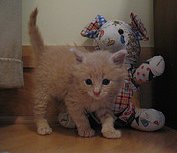Feral Kitten
Many people come across an abandoned feral kitten from time to time, and for any cat lover it is a natural instinct to seriously consider scooping it up and taking it home. However, it is important to actually determine that the kitten has actually been abandoned before you take it off.
You may find that the mother is actually close by – perhaps hunting for food – and will be back to look after her baby. If the kitten looks as though it is well nourished and healthy then the mother probably is around. If it is in poor condition then it may well have been abandoned.
Once you're sure that it is a neglected feral kitten you can make a more informed decision. However, remember that taking care of a feral cat is a lot more involved than taking care of a regular kitten that has been brought up by his mother. That is not to say that you should just leave the kitten and walk away – if it has definitely been abandoned there are a number of options, such as a cat rescue centre, your home, asking a friend with plenty of time available to take the kitten in, etc.
With a feral kitten, things like litter training may be more difficult, as might teaching the kitten not to scratch and claw anything it comes across. It may also be more difficult to integrate the kitten into a household with other pets.
Normally, a kitten shouldn't be taken from its mother until 5 to 6 weeks of age, although, if the mother is feral that's a different story. A feral kitten should be removed from a wild feral mother as early as possible. The longer a feral kitten stays with its mother, the harder he will be to tame in the future.
Keep the Kitten Warm
Very young kittens, under 3 weeks of age, can't control or maintain their own body temperatures. Use either a hot water bottle or a heating pad to keep their temperature at a normal level. To do this, wrap a heating pad in a towel, keeping it on the lowest setting. If using a hot water bottle, lightly fill it with water, keeping the temperature around 100 degrees Fahrenheit. It is crucial for you to do this to keep the kitten from getting too cold. Keep him in a spot that's free of drafts, such as a box or carrier, and be sure to keep him away from any other animals. For even more warmth, put a blanket or towel over top of the box.
Take the feral kitten to the vet for a complete check up. It may be a good idea to provide a sample of their stool if you can get one; this way your vet has something to check for possible worms or parasites.
-- Feral Kitten --
Proper Diet for The Kitten
Do not give the kitten regular cow's milk, as it doesn't have enough nutritional value for a growing kitten and it can cause diarrhoea. If you can't get to a pet store, try one of these kitten formula recipes.
Kitten Formula Recipes
8 oz homogenized whole milk
2 egg yolks
1 teaspoon salad oil
1 drop liquid pediatric vitamins (this is optional)
Mix all ingredients together and warm it up on the stove for a minute or two before using (Be sure to test a small amount on your wrist to make sure that the milk is not too hot). Keep refrigerated.
Or try this one:
1 can Evaporated Milk
1 egg yolk
2 tablespoons Karo syrup
Another kitten formula recipe:
1 qt whole goat's milk
1 teaspoon light Karo syrup
1 tablespoon nonfat plain yogurt (goat's milk is preferred)
1 egg yolk
Knox unflavored gelatin:
Newborn-1 week 1 pkg
2nd week 1 1/2 - 2 pkgs
3rd week 2 1/2 - 3 pkgs
4th week 4 pkgs
Now that you've made your own formula, or purchased some from a store, use a small baby bottle to feed the kitten. It's important to sterilize the baby bottle and nipples before feeding.
Whenever you feed your kitten, make sure the formula is at room temperature. Do this by warming it in the microwave for about 10 seconds, or place it in a bowl filled with hot water for a few minutes.
Prevent contamination when feeding the kitten by wearing a clean shirt or apron. Hold the bottle at a 45 degree angle to keep air from getting into the kitten's stomach.
What if the kitten won't take to the bottle?
Try rubbing the kitten's forehead or back. This should help relax him, and mimic the feeling of his mother cleaning him. If he still won't nurse, try to stimulate sucking by rubbing some Karo syrup onto his lips.
If after all of this the kitten still won't nurse, there's a good chance he's sick. It is important that in this situation you seek the advice of a vet, as the kitten may need treatment.
 Courtesy of Flikr user Pat Hooper
Courtesy of Flikr user Pat HooperImportant Note If you notice the feral kitten starts to choke, and he has sucked formula into his lungs, turn him upside down until he stops choking.
-- Feral Kitten --
How much should you be feeding your new kitten, and how often?
How much, and when you feed your kitten all depends on the kitten's age.
- Under 1 week old - Needs to feed every 2-3 hours
- 2 weeks old - Needs to feed every 4-6 hours
- 3 weeks until weaned - Needs to feed every 6-8 hours
When the kitten has eaten enough, bubbles will form around his mouth, and his stomach will be round and plump. Each time you feed the kitten, "burp" him just like you would a baby.
How much should your new kitten gain in weight?
Kittens should gain on average around 1/2 oz each day or 4 ounces in a week.
At four to five weeks you can begin weaning the kitten. The signs that your kitten is ready are if he bites the nipple of the bottle forcefully, or if he's licking formula from your finger.
You need to wean your kitten in steps, first by trying to get him to lick off a spoon, then by putting some formula into a dish.
Once your kitten is weaned off the bottle, you can begin mixing in other foods. First start mixing in baby food with the formula. Try something with chicken or some kind of meat for protein. Be sure that no onion is in it.
Next you can mix the kitten formula with some canned kitten food.
During this process, weight gain may slow down and you may see some diarrhoea. Kittens can not chew anything until 8 weeks, so if you give him anything dry, be sure to moisten it first.
Once your kitten reaches 12 months of age you can start giving him adult cat food. You can choose from complete dry cat food, canned food, or a combination. Up until a year old make sure that you give the kitten proper kitten food (dry or canned) as this has the right nutrition for a growing kitten.
Getting your Kitten To Use The Litter Box
How do you help a kitten eliminate, and when will he be able to use a litter box?
This part of caring for a young cat may not be for the faint of heart. You will need to stimulate your kitten's bowels and bladder so the kitten will be able to eliminate.
This can be done by rubbing his lower belly, genitals and rectum with a cotton pad, q-tip or tissue that has been moistened with warm water. Be careful when doing this, as you do not want to rub in excess and over stimulate. This can cause irritation.
 Courtesy of Flikr user Ryan Forsythe
Courtesy of Flikr user Ryan ForsytheOnce a kitten reaches four weeks of age you can then begin to start litter box training your feral kitten.
-- Feral Kitten --
Kitten Grooming Habits
You may need to teach your kitten proper grooming habits. This is because, if the kitten was taken away at a young age from his mother, he may not have experienced her bathing him.
Bathe him yourself by gently stroking a warm wash cloth over his body using short strokes. This will help show him how to groom and clean himself the right way.
While cleaning your kitten, look in his ears for any signs of dirt or mites. Check for fleas too. A young kitten can get anemia, or have serious complications from a flea infestation, so it's important to check for fleas and treat them promptly.
Check for any signs of scratching, skin irritation, or any patches of missing fur. This could be an indication of ring-worms or mange. Seek treatment if you notice any of these symptoms.
Kitten Milestones
Here is a list of important milestones to watch for while caring for your new kitten. Each feral kitten varies, some may mature sooner, others later. It all depends on the individual cat.
- At birth, the weight is around 2-4 ounces, their weight doubles in the first week.
- At 7 to 10 days they open their eyes.
- Their eyes stay blue until 6-7 weeks. Their true color doesn't settle until they are 3 months old.
- They start crawling at 3 weeks.
- Their ears point up at 3 1/2 weeks.
- At four weeks, they begin to play and start teething.
Medications and Vaccinations
What is the proper age to start vaccinations and medications?
If your kitten has ring-worm, treatment can be given as young as two weeks. A 2nd dose will be given two weeks later. For tapeworms, kittens can be treated when they reach 6 weeks.
The FVRCP (Feline Viral Rhinotracheitis) vaccination can be given at 6 weeks and FeLV can be given at 8 weeks. You should consult your vet to find out which vaccinations and medications your kitten may need.
-- Feral Kitten --
Spay & Neutering
It is a good idea to have the feral kitten spayed or neutered for a number of reasons. Not only to prevent any unwanted kittens from being born, but it also prevents several health problems.
When a feral kitten has reached 8 to 9 weeks, is healthy and weighs at least 2 pounds, they can be spayed or neutered.
-- Feral Kitten --
Home » Cat Health Problems » Feral Kitten
Come and join us
We're a thriving community on Facebook, too. Click the Like button below to follow along, then pop on over and say hi.
If this feels like your kind of place, why not bookmark us and visit us again? We'd love to see you. Links to new or updated pages are always included in What's New?
Or, to make sure you never miss out on anything, use the form below to sign up for our newsletter.
Enjoy this? Don't miss out
Sign up for our free newsletter!
Our monthly stroll through items of interest, news and stories, photos, tips, and our cats of the Month.
Don't worry — your e-mail address is totally secure.
I promise to use it only to send you Siamese Cats.
.



